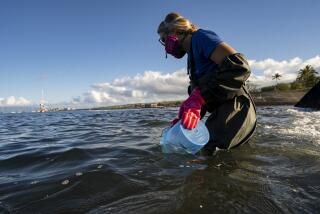Deep-sea microbes live life in the extremely slow lane
Had enough of life in the fast lane and looking to take it down a notch or two? You might seek guidance from a colony of deep-sea microbes harvested from the barren depths of the Pacific Ocean that are progressing so slowly, they almost appear to be dead.
Just how plodding are these ancient creatures, who are buried about 100 feet deep in the seabed? Some of them haven’t received any new food for 86 million years, when dinosaurs still walked the Earth. And they are using up oxygen at rates 10,000 times slower than their counterparts on the surface of the ocean floor.
“What they’re doing, they’re doing so slow that from our time perspective, it just looks like suspended animation,” said biologist Hans Roy, who reported on the creatures in Friday’s edition of the journal Science.
The single-cell organisms live in such extreme conditions that they could help astrobiologists search for evidence of life on less hospitable planets, scientists said.
The ocean floor contains a wealth of microbial life — some experts estimate that nearly 90% of microorganisms on the planet live beneath the seabed.
“There’s an abundant biosphere below the surface skin where we live ... and yet most of what is down there is living at a pace and in a mode that we don’t have represented in the world around us,” said Tori Hoehler, a biogeochemist at the NASA Ames Research Center’s exobiology branch near San Jose, who was not involved in the study. “Most of life lives in a mode we don’t understand at all.”
Chief among them are the slow-living microbes, which were discovered several years ago, said Roy, who is based at Aarhus University in Denmark.
Roy was part of a team of scientists that set out on a ship in 2009 to sample spots around the Galapagos Islands along the equator and up toward an area near Hawaii in the northern Pacific, where ocean currents block nutrient-rich sediments from falling to the ocean floor. That keeps microbes at the bottom from receiving fresh food.
The researchers drilled deep into the ocean floor and extracted a core sample that was about 100 feet long. Among other things, they examined the oxygen levels in the successive layers of thick, grayish mud using needle-like sensors.
When the researchers measured the rate of oxygen respiration, they found that there were still microbes eking out a meager existence in the deepest layers.
The age of these microbes is unclear. Estimates range from a few centuries to many millions of years, researchers said.
Nor is it clear that they’re growing. The creatures could simply be repairing normal cellular wear and tear.
As Hoehler put it in an email, they “are ‘breathing’ at a rate about 2 million times slower than a typical human cell (which is admittedly quite a bit larger).”
Without nature’s help, such slow progress would have taken centuries to track in a lab experiment, Roy said.
Understanding how these microbes survive in such extreme low-nutrient environments could provide pointers for scientists looking for life on other planets, such as Mars. In the search for extraterrestrial life, Hoehler said, such slow-life communities below the bottom of the sea “may be a much better point of reference for us than what’s up here.”
SCIENCE NOW: Discoveries from the world of science and medicine







